I have some data that I plot using the geom_polygon in ggplot (data pasted at the end).
# GGplot: anomaly for ONI region 3.4 --------------------------------------
library(ggplot2)
library(tidyverse)
ggplot(data = onisoiquimalypense3, mapping = aes(x = date, y = value)) +
geom_polygon(linetype = 1, fill = "darkgray", alpha= 1) +
theme_bw() +
geom_abline(intercept = c(-0.5, 0.5), slope = 0,linetype = 2) +
xlab("Year") +
ylab("3-Month Oceanic Niño Index (ONI)")
I'd like to have parts of the area of the polygon to be coloured red if the polygon crosses 0.5 (dashed line) and colour blue if it crosses -0.5 (see the pointed parts).
Something like this, but for ggplot. Is there an automatic way to set that in ggplot?
Data
## Reading data ------------------------------------------------------------
# Data from https://origin.cpc.ncep.noaa.gov/products/analysis_monitoring/ensostuff/ONI_v5.php
onisoiquimalypense3 = structure(list(Year = c(2016L, 2016L, 2016L, 2016L, 2016L, 2016L,
2016L, 2016L, 2016L, 2016L, 2016L, 2016L, 2016L, 2017L, 2017L,
2017L, 2017L, 2017L, 2017L, 2017L, 2017L, 2017L, 2017L, 2017L,
2017L, 2018L, 2018L, 2018L, 2018L, 2018L, 2018L, 2018L, 2018L,
2018L, 2018L, 2018L, 2018L, 2019L, 2019L, 2019L, 2019L, 2019L,
2019L, 2019L, 2019L, 2019L, 2019L, 2019L, 2019L, 2020L, 2020L,
2020L, 2020L, 2020L, 2020L, 2020L, 2020L, 2020L, 2020L, 2020L,
2020L, 2021L, 2021L, 2021L, 2021L, 2021L, 2021L, 2021L, 2021L,
2021L, 2021L, 2021L, 2021L, 2022L, 2022L, 2022L, 2022L, 2022L,
2022L, 2022L, 2022L, 2022L, 2022L, 2022L, 2022L, 2022L, 2022L
),
name = c("DJF", "DJF", "JFM", "FMA", "MAM", "AMJ", "MJJ",
"JJA", "JAS", "ASO", "SON", "OND", "NDJ", "DJF", "JFM", "FMA",
"MAM", "AMJ", "MJJ", "JJA", "JAS", "ASO", "SON", "OND", "NDJ",
"DJF", "JFM", "FMA", "MAM", "AMJ", "MJJ", "JJA", "JAS", "ASO",
"SON", "OND", "NDJ", "DJF", "JFM", "FMA", "MAM", "AMJ", "MJJ",
"JJA", "JAS", "ASO", "SON", "OND", "NDJ", "DJF", "JFM", "FMA",
"MAM", "AMJ", "MJJ", "JJA", "JAS", "ASO", "SON", "OND", "NDJ",
"DJF", "JFM", "FMA", "MAM", "AMJ", "MJJ", "JJA", "JAS", "ASO",
"SON", "OND", "NDJ", "DJF", "JFM", "FMA", "MAM", "AMJ", "MJJ",
"JJA", "JAS", "ASO", "SON", "OND", "NDJ", "NDJ", "NDJ"),
value = c(0,
2.5, 2.1, 1.6, 0.9, 0.4, -0.1, -0.4, -0.5, -0.6, -0.7, -0.7,
-0.6, -0.3, -0.2, 0.1, 0.2, 0.3, 0.3, 0.1, -0.1, -0.4, -0.7,
-0.8, -1, -0.9, -0.9, -0.7, -0.5, -0.2, 0, 0.1, 0.2, 0.5, 0.8,
0.9, 0.8, 0.7, 0.7, 0.7, 0.7, 0.5, 0.5, 0.3, 0.1, 0.2, 0.3, 0.5,
0.5, 0.5, 0.5, 0.4, 0.2, -0.1, -0.3, -0.4, -0.6, -0.9, -1.2,
-1.3, -1.2, -1, -0.9, -0.8, -0.7, -0.5, -0.4, -0.4, -0.5, -0.7,
-0.8, -1, -1, -1, -0.9, -1, -1.1, -1, -0.9, -0.8, -0.9, -1, -1,
-0.9, -0.8, 0, 0),
month.mean = c("1", "1", "2", "3", "4", "5",
"6", "7", "8", "9", "10", "11", "12", "1", "2", "3", "4", "5",
"6", "7", "8", "9", "10", "11", "12", "1", "2", "3", "4", "5",
"6", "7", "8", "9", "10", "11", "12", "1", "2", "3", "4", "5",
"6", "7", "8", "9", "10", "11", "12", "1", "2", "3", "4", "5",
"6", "7", "8", "9", "10", "11", "12", "1", "2", "3", "4", "5",
"6", "7", "8", "9", "10", "11", "12", "1", "2", "3", "4", "5",
"6", "7", "8", "9", "10", "11", "12", "12", "12"),
date = structure(c(16801,
16801, 16832, 16861, 16892, 16922, 16953, 16983, 17014, 17045,
17075, 17106, 17136, 17167, 17198, 17226, 17257, 17287, 17318,
17348, 17379, 17410, 17440, 17471, 17501, 17532, 17563, 17591,
17622, 17652, 17683, 17713, 17744, 17775, 17805, 17836, 17866,
17897, 17928, 17956, 17987, 18017, 18048, 18078, 18109, 18140,
18170, 18201, 18231, 18262, 18293, 18322, 18353, 18383, 18414,
18444, 18475, 18506, 18536, 18567, 18597, 18628, 18659, 18687,
18718, 18748, 18779, 18809, 18840, 18871, 18901, 18932, 18962,
18993, 19024, 19052, 19083, 19113, 19144, 19174, 19205, 19236,
19266, 19297, 19327, 19327, 19327), class = "Date"),
elnlan = c("El Nino",
"El Nino", "El Nino", "El Nino", "El Nino", "none", "none", "none",
"none", "La Nina", "La Nina", "La Nina", "La Nina", "none", "none",
"none", "none", "none", "none", "none", "none", "none", "La Nina",
"La Nina", "La Nina", "La Nina", "La Nina", "La Nina", "none",
"none", "none", "none", "none", "none", "El Nino", "El Nino",
"El Nino", "El Nino", "El Nino", "El Nino", "El Nino", "none",
"none", "none", "none", "none", "none", "none", "none", "none",
"none", "none", "none", "none", "none", "none", "La Nina", "La Nina",
"La Nina", "La Nina", "La Nina", "La Nina", "La Nina", "La Nina",
"La Nina", "none", "none", "none", "none", "La Nina", "La Nina",
"La Nina", "La Nina", "La Nina", "La Nina", "La Nina", "La Nina",
"La Nina", "La Nina", "La Nina", "La Nina", "La Nina", "La Nina",
"La Nina", "La Nina", "La Nina", "La Nina")), row.names = c(NA,
-87L),
class = c("tbl_df", "tbl", "data.frame"))
Edit
I did try some solutions and the closest I could get is getting 3 layers.
my.lev = .5
my.lev2 = -.5
ggplot(data = onisoiquimalypense3, mapping = aes(x = date, y = value)) +
# geom_area(aes(fill=col)) +
geom_polygon(linetype = 1, fill = "darkgray", alpha= 1) +
geom_ribbon(aes(
ymin = my.lev, ymax = ifelse(value >= my.lev, value, my.lev),
), fill = "blue") +
geom_ribbon(aes(
ymax = my.lev2, ymin = ifelse(value >= my.lev2, my.lev2, value)
), fill = "red") +
theme_bw() +
geom_abline(intercept = c(-0.5, 0.5), slope = 0,linetype = 2) +
xlab("Year") +
ylab("3-Month Oceanic Niño Index (ONI)")
But for some reason, the alignment between the 2 polygons (see black circles in the attached image) is not great. Is there a way to make it better looking (overlapping: so that only the colour changes)


